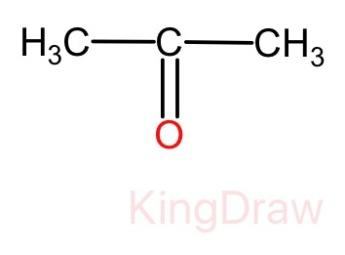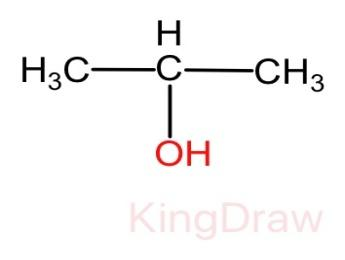Answer
36.9k+ views
Hint: The Tollen's reagent test is used to distinguish between aldehyde and a ketone. If after the reaction a silver mirror is formed then it indicates the presence of a ketone group, else an aldehyde group is present.
Complete step by step answer: It is given in the question that a compound X that has a molecular formula ${C}_{3}{H}_{8}O$ is treated with acidified potassium dichromate to form a product (Y) with molecular formula ${C}_{3}{H}_{6}O$. The reaction can be written as follows.
$ \underset { ({ C }_{ 3 }{ H }_{ 8 }O) }{ X } \quad \xrightarrow [ { K }_{ 2 }{ Cr }_{ 2 }{ O }_{ 7 } ]{ H^{ + } } \quad \underset { ({ C }_{ 3 }{ H }_{ 6 }O) }{ Y }$
And then the compound Y, when heated with ammoniacal $Ag{NO}_{3}$ does not give a shining silver mirror. After this the compound Y is made to react with an aqueous solution of $N{H}_{2}CONHN{H}_{2}$, HCl and sodium acetate, gives a product (Z). The reaction can be written as follows.
\[\underset{({{C}_{3}}{{H}_{6}}O)}{\mathop{Y}}\,\quad \xrightarrow[{}]{Aq.(N{{H}_{2}}CONHN{{H}_{2}}+HCl+C{{H}_{3}}CO{{O}^{-}}N{{a}^{+}})}\quad Z\]
Let us now find out the compounds X, Y, and Z.
We know that aldehydes gives a shining silver mirror but in this case no shining silver mirror is formed. Therefore, from this we can come to the conclusion that the compound Y is a ketone. Thus, the molecular structure of compound Y is given as:

And we know that the compound X is getting oxidized with the help of potassium dichromate. Therefore, the compound X must be alcohol. Thus, the molecular structure of compound X is given as:

Now the reaction of compound X to form compound Y when treated with acidic potassium dichromate can be given as follows.
$ \underset { Propan-2-ol }{ C{ H }_{ 3 }-CH(OH)-C{ H }_{ 3 } } \quad \xrightarrow [ { K }_{ 2 }{ Cr }_{ 2 }{ O }_{ 7 } ]{ H^{ + } } \quad \underset { Propanone }{ C{ H }_{ 3 }-CO-C{ H }_{ 3 } }$
And further, when the ketone i.e., propanone is reacted with an aqueous solution of $N{H}_{2}CONHN{H}_{2}$, HCl and sodium acetate, the oxygen in the compound Y gets replaced by $N{H}_{2}NHCON{H}_{2}$. The reaction involved is given as:
$\underset{Propanone}{\mathop{C{{H}_{3}}-CO-C{{H}_{3}}}}\,\quad \xrightarrow[{}]{Aq.(N{{H}_{2}}CONHN{{H}_{2}}+HCl+C{{H}_{3}}CO{{O}^{-}}N{{a}^{+}})}\quad {{(C{{H}_{3}})}_{2}}=NNHCON{{H}_{2}}$
Therefore, the compound Z is ${(C{H}_{3})}_{2}=NNHCON{H}_{2}$. Hence, option (B) is the correct option.
Note: The $-N{H}_{2}$ group is an electron withdrawing group and shows -I effect. And the more the no. of EWG, the more the electron density at the atom and thus more reactive. Therefore, $N{H}_{2}NHCON{H}_{2}$ gets attached from the side which has more no. of $-N{H}_{2}$ groups.
Complete step by step answer: It is given in the question that a compound X that has a molecular formula ${C}_{3}{H}_{8}O$ is treated with acidified potassium dichromate to form a product (Y) with molecular formula ${C}_{3}{H}_{6}O$. The reaction can be written as follows.
$ \underset { ({ C }_{ 3 }{ H }_{ 8 }O) }{ X } \quad \xrightarrow [ { K }_{ 2 }{ Cr }_{ 2 }{ O }_{ 7 } ]{ H^{ + } } \quad \underset { ({ C }_{ 3 }{ H }_{ 6 }O) }{ Y }$
And then the compound Y, when heated with ammoniacal $Ag{NO}_{3}$ does not give a shining silver mirror. After this the compound Y is made to react with an aqueous solution of $N{H}_{2}CONHN{H}_{2}$, HCl and sodium acetate, gives a product (Z). The reaction can be written as follows.
\[\underset{({{C}_{3}}{{H}_{6}}O)}{\mathop{Y}}\,\quad \xrightarrow[{}]{Aq.(N{{H}_{2}}CONHN{{H}_{2}}+HCl+C{{H}_{3}}CO{{O}^{-}}N{{a}^{+}})}\quad Z\]
Let us now find out the compounds X, Y, and Z.
We know that aldehydes gives a shining silver mirror but in this case no shining silver mirror is formed. Therefore, from this we can come to the conclusion that the compound Y is a ketone. Thus, the molecular structure of compound Y is given as:

And we know that the compound X is getting oxidized with the help of potassium dichromate. Therefore, the compound X must be alcohol. Thus, the molecular structure of compound X is given as:

Now the reaction of compound X to form compound Y when treated with acidic potassium dichromate can be given as follows.
$ \underset { Propan-2-ol }{ C{ H }_{ 3 }-CH(OH)-C{ H }_{ 3 } } \quad \xrightarrow [ { K }_{ 2 }{ Cr }_{ 2 }{ O }_{ 7 } ]{ H^{ + } } \quad \underset { Propanone }{ C{ H }_{ 3 }-CO-C{ H }_{ 3 } }$
And further, when the ketone i.e., propanone is reacted with an aqueous solution of $N{H}_{2}CONHN{H}_{2}$, HCl and sodium acetate, the oxygen in the compound Y gets replaced by $N{H}_{2}NHCON{H}_{2}$. The reaction involved is given as:
$\underset{Propanone}{\mathop{C{{H}_{3}}-CO-C{{H}_{3}}}}\,\quad \xrightarrow[{}]{Aq.(N{{H}_{2}}CONHN{{H}_{2}}+HCl+C{{H}_{3}}CO{{O}^{-}}N{{a}^{+}})}\quad {{(C{{H}_{3}})}_{2}}=NNHCON{{H}_{2}}$
Therefore, the compound Z is ${(C{H}_{3})}_{2}=NNHCON{H}_{2}$. Hence, option (B) is the correct option.
Note: The $-N{H}_{2}$ group is an electron withdrawing group and shows -I effect. And the more the no. of EWG, the more the electron density at the atom and thus more reactive. Therefore, $N{H}_{2}NHCON{H}_{2}$ gets attached from the side which has more no. of $-N{H}_{2}$ groups.
Recently Updated Pages
If a wire of resistance R is stretched to double of class 12 physics JEE_Main

The path difference between two waves for constructive class 11 physics JEE_MAIN

What is the difference between solvation and hydra class 11 chemistry JEE_Main

IfFxdfrac1x2intlimits4xleft 4t22Ft rightdt then F4-class-12-maths-JEE_Main

Sodium chloride is purified by passing hydrogen chloride class 11 chemistry JEE_Main

Consider the following oxyanions PO43P2O62SO42MnO4CrO4S2O52S2O72 class 11 chemistry JEE_Main

Other Pages
The mole fraction of the solute in a 1 molal aqueous class 11 chemistry JEE_Main

If a wire of resistance R is stretched to double of class 12 physics JEE_Main

Lowering in vapour pressure is highest for A 02 m urea class 11 chemistry JEE_Main

An electric bulb has a power of 500W Express it in class 11 physics JEE_Main

Which of the following Compounds does not exhibit tautomerism class 11 chemistry JEE_Main

The ratio of speed of sound in Hydrogen to that in class 11 physics JEE_MAIN



